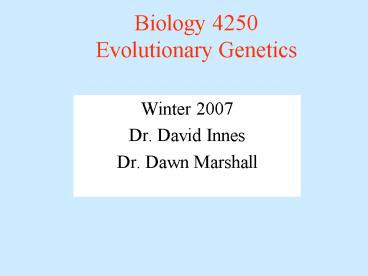Biology 4250 Evolutionary Genetics - PowerPoint PPT Presentation
1 / 20
Title:
Biology 4250 Evolutionary Genetics
Description:
Hermaphrodite -- bisexual flower with both stamens and pistil ... Hermaphrodite -- the plant has ... Gynodioecious -- has both female and hermaphrodite plants ... – PowerPoint PPT presentation
Number of Views:283
Avg rating:3.0/5.0
Title: Biology 4250 Evolutionary Genetics
1
Biology 4250 Evolutionary Genetics
- Winter 2007
- Dr. David Innes
- Dr. Dawn Marshall
2
Outline of topics 1. Introduction/History of
Interest in Genetic Variation 2. Types of
Molecular Markers 3. Molecular Evolution 4.
Individuality and Relatedness 5. Population
Demography, Population Structure 6. Phylogenetic
Methods Species Level Phylogenies --------
Midterm break ---------------------
(Midterm test in lab. Feb. 26) 7.
Phylogeography 8. Speciation, Hybridization and
Introgression 9. Human Evolutionary Genetics 10.
Conservation Genetics
Background
Applications
3
Individuality and Parentage
- Human Forensics
- Ramets and Genets (sexual and asexual)
- Genetic chimeras
- Gender ascertainment
- Genetic parentage
4
Genetic Parentage - Situations
- 1. Maternity and paternity uncertain
- 2. Maternity certain paternity among candidate
males - 3. Hermaphroditic selfing
- outcrossing
- 4. Selfing vs. parthenogenesis
monogamy
polyandry
polygyny
polygynandry
5
Genetic Parentage
- Primates dominant/subdominant males
- Birds extra-pair copulation
- Fish various monogamy ? polygynandry
- role-reversal
6
Plant Mating Systems
In a word Diverse
Silene acaulis Gynodioecious (hermaphrodites
females)
7
Plant Mating Systems
- Individual Flowers
- Hermaphrodite -- bisexual flower with both
stamens and pistil - Unisexual -- flower is either staminate
(male), or pistillate (or carpellate) (female) - Individual Plants
- Hermaphrodite -- the plant has only
hermaphrodite flowers - Monoecious -- unisexual male and female
flowers are on the same plant - Dioecious -- unisexual male and female
flowers are on different plants - Gynoecious -- has only female flowers
- Androecious -- has only male flowers
- Plant Populations
- Hermaphrodite -- only hermaphrodite plants
- Monoecious -- only monoecious plants
- Dioecious -- only dioecious plants
- Gynodioecious -- has both female and
hermaphrodite plants - Androdioecious -- has both male and
hermaphrodite plants
8
Parentage in Plant
- Paternal fitness
- ? spread of pollen (wind or insect)
- Mother known (seeds)
- - paternity to be determined
9
Parentage in Plant
- Many plant species hermaphroditic
- Prevention of selfing (several mechanism)
- - M F mature at different times
- - anther stigma separation
- - genetic self-incompatibility
- - sex expression
10
Prevention of Selfing in Plants
Primula veris
- 1. Spatial and Temporal
- - dichogamy (protandry and protogyny)
- - herkogamy (spatial separation)
- 2. Self-Incompatibility (SI)
- - homomorphic SI
- (gametophytic and sporophytic)
- heteromorphic SI
- (distyly and tristyly)
- 3. Sex Expression
- - monoecy, dioecy, gynodioecy, etc.
Style length
Thrum Pin
Pin Thrum
11
Parentage in Plant
- 1. Relative proportion of selfing vs. outcrossing
- Mother known ? paternity assessed using genetic
markers - non-maternal alleles outcrossing
- Statistical models mixed mating model
- s selfing rate
- t outcrossing rate
- s t 1.0
12
Out-crossing Rates
- Distribution of outcrossing rates Bimodal
- most species either predominantly
outcrossing or selfing - - Outcrossing selected when inbreeding
depression high - - Selfing selected in species that have purged
recessive deleterious alleles - Large variation among populations in outcrossing
rate
13
Outcrossing Rates
Pollination Wind animal
Variation among hermaphroditic species
Variation among populations
14
Paternity in Plants
- 2. Outcrossing established determination
Paternity - - compare seeds (progeny) genotype with
mother - - deduce haploid genotype of fertilizing
pollen - - candidate fathers screened ? paternity
exclusion - - direct estimate of gene flow
- Example wild radish (Raphanus sativus)
15
Paternity in Wild Radish
- - Self-incompatible, insect pollinated
- - Six highly polymorphic allozyme loci
- - Multiple paternity found for all maternal
plants (85 of all fruits - - Minimum of 2.3 paternal donors per maternal
plant - - Most multiply-sired fruits due to a single
insect visit - (pollen carryover)
- 44 of paternity from 100 m (gene flow between
1 generation)
16
Paternity in Moss
- Female (n) sporophyte (2n) ? deduce male (n)
genotype - Results
- - only 2/137 matings involved a single male
not previously sampled in the area - - at sites where both M F occurred, 93 of
94 matings involved M F at the same site - - Conclusion sperm dispersal limited
SS SF SM 2n S F M female S
S S male
17
Other Topics in Parentage
- Sperm storage females can store sperm after a
- single copulation?
- - mammals few days
- - birds, insects weeks
- - salamander months
- - snakes, turtles several years
18
Other Topics in Parentage
- Sperm and pollen competition
- - sperm from two or more males in direct
competition - for fertilization of eggs of a single
female - - many mechanisms for a male to ensure his
sperm - fertilizes a females eggs (paternity
assurance) - - plugs scoop out previous
males sperm - prolonged copulation multiple
copulation - with same female mate guarding
- Females may encourage sperm competition
19
Other Topics in Parentage
- Sperm and pollen competition
- - multiply inseminated females? markers used
to - determine the success of each male
- first male, last male, no mating order
effect - Insects often last male has greatest
fertilization success - Plants pollination by multiple pollen donors
- competition ? rate of pollen tube
growth - usually advantage for first
pollinating male
20
Paternity Software
- http//www.bio.ulaval.ca/louisbernatchez/downloads
.htm































